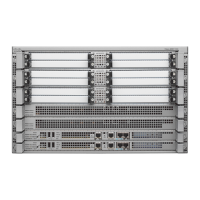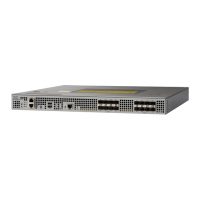15-10
Cisco ASR 1000 Series Aggregation Services Routers SIP and SPA Software Configuration Guide
OL-14127-08
Chapter 15 Configuring the 8-Port Channelized T1/E1 SPA
Configuration Tasks
Timeslot(s) Used:1-24, subrate: 64Kb/s, transmit delay is 0 flags
Configuring the CRC Size for T1
All 8-Port Channelized T1/E1 SPA interfaces use a 16-bit cyclic redundancy check (CRC) by default,
but also support a 32-bit CRC. CRC is an error-checking technique that uses a calculated numeric value
to detect errors in transmitted data. The designators 16 and 32 indicate the length (in bits) of the frame
check sequence (FCS). A CRC of 32 bits provides more powerful error detection, but adds overhead.
Both the sender and receiver must use the same setting.
CRC-16, the most widely used CRC throughout the United States and Europe, is used extensively with
WANs. CRC-32 is specified by IEEE 802 and as an option by some point-to-point transmission
standards. It is often used on Switched Multimegabit Data Service (SMDS) networks and LANs.
To set the length of the cyclic redundancy check (CRC) on a T1 interface, use the following:
Verifying the CRC Size
Use the show interfaces serial command to verify the CRC size set on the interface:
Router# show interfaces serial 6/0/0:0
Serial6/0/0:0 is up, line protocol is up
Hardware is SPA-T1E1
MTU 1500 bytes, BW 1536 Kbit, DLY 20000 usec,
reliability 255/255, txload 1/255, rxload 1/255
Encapsulation PPP, crc 32, loopback not set
Keepalive set (10 sec)
LCP Open, multilink Open
Last input 00:00:38, output 00:00:00, output hang never
Last clearing of "show interface" counters 01:46:16
Input queue: 0/75/0/0 (size/max/drops/flushes); Total output drops: 0
Queueing strategy: fifo
Output queue: 0/40 (size/max)
30 second input rate 0 bits/sec, 0 packets/sec
30 second output rate 0 bits/sec, 0 packets/sec
1272 packets input, 20396 bytes, 0 no buffer
Received 0 broadcasts (0 IP multicast)
0 runts, 0 giants, 0 throttles
6 input errors, 3 CRC, 0 frame, 0 overrun, 0 ignored, 3 abort
1276 packets output, 20460 bytes, 0 underruns
0 output errors, 0 collisions, 0 interface resets
0 output buffer failures, 0 output buffers swapped out
0 carrier transitions no alarm present
Timeslot(s) Used:1-24, subrate: 64Kb/s, transmit delay is 0 flags
Command Purpose
Router# configure terminal Enters global configuration mode.
Router(config)# interface serial
slot/subslot/port:channel-group
Selects the interface to configure.
• slot/subslot/port:channel-group—Specifies
the location of the interface. See the
“Specifying the Interface Address on a SPA”
section on page 15-6.
Router(config-if)# crc {16 | 32} Selects the CRC size in bits.
• 16—16-bit CRC. This is the default
• 32—32-bit CRC.

